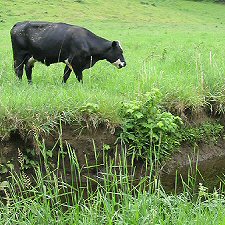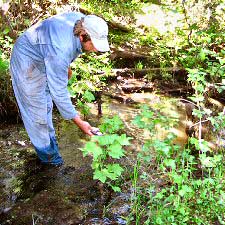Overview
 OWEB and the Washington Salmon Recovery Funding Board (SRFB) worked cooperatively to monitor livestock exclusion projects in both states as part of the agencies' effectiveness monitoring program for watershed and salmon habitat restoration projects. Livestock exclusion, which includes building and maintaining fences along riparian areas, has been identified as an important action for restoring fragile riparian areas. This coordinated approach represents a successful effort to collect comparable data across jurisdictional boundaries, thus increasing efficiencies in monitoring and strengthening the statistical power of the monitoring study.
OWEB and the Washington Salmon Recovery Funding Board (SRFB) worked cooperatively to monitor livestock exclusion projects in both states as part of the agencies' effectiveness monitoring program for watershed and salmon habitat restoration projects. Livestock exclusion, which includes building and maintaining fences along riparian areas, has been identified as an important action for restoring fragile riparian areas. This coordinated approach represents a successful effort to collect comparable data across jurisdictional boundaries, thus increasing efficiencies in monitoring and strengthening the statistical power of the monitoring study.
Please see the Documents section for reports on this monitoring effort.
Project Summary
This project employs a Before-After-Control-Impact (BACI) design, which means that data is collected both Before and After an Impact (fence-building, in this case). The Control is established in areas not expected to change during the project. This specialized design helps to isolate changes caused by an Impact by comparing the After conditions of the impacted reach against both the Before conditions and the Control. This project is collecting data addressing livestock presence in the exclusion, bank erosion, and riparian vegetation structure at each project site. Monitoring takes place 1, 3, 5, and 10 years after fence installation.
OWEB and SRFB partnered to hire a contractor to monitor the effectiveness of twelve livestock exclusion projects. The final reports for baseline sampling (Year 0) and Year 1, Year 3, Year 5, and Year 11 are posted in the Documents section of this page.
Lessons Learned

- Riparian planting may also be needed at the time fencing is installed to advance riparian diversity.
- Invasive species control in the exclusion may also be necessary to allow native species to mature.
- In some cases, uncontrollable natural events, such as trees falling across the fence structure, resulted in a project being non-functional. However, in other cases, clear evidence of livestock access to the stream due to improperly installed or maintained structures was found.
- It is imperative that fences are installed with the intent to exclude livestock from the stream for the life of the project or longer and that they are maintained in properly working condition.
- It is challenging to find suitable control sites to compare to treatment sites over a 10-year study.
Contact
Please direct questions or comments to
Ken Fetcho, Effectiveness Monitoring Coordinator, 971-345-7018.